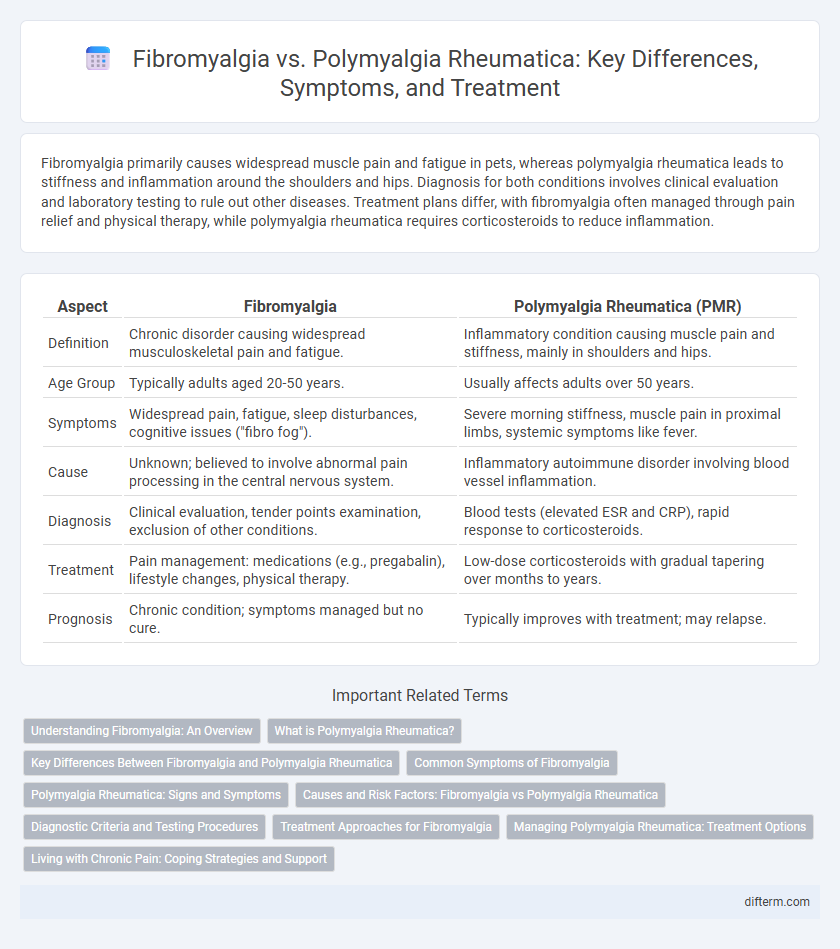Fibromyalgia primarily causes widespread muscle pain and fatigue in pets, whereas polymyalgia rheumatica leads to stiffness and inflammation around the shoulders and hips. Diagnosis for both conditions involves clinical evaluation and laboratory testing to rule out other diseases. Treatment plans differ, with fibromyalgia often managed through pain relief and physical therapy, while polymyalgia rheumatica requires corticosteroids to reduce inflammation.
Table of Comparison
| Aspect | Fibromyalgia | Polymyalgia Rheumatica (PMR) |
|---|---|---|
| Definition | Chronic disorder causing widespread musculoskeletal pain and fatigue. | Inflammatory condition causing muscle pain and stiffness, mainly in shoulders and hips. |
| Age Group | Typically adults aged 20-50 years. | Usually affects adults over 50 years. |
| Symptoms | Widespread pain, fatigue, sleep disturbances, cognitive issues ("fibro fog"). | Severe morning stiffness, muscle pain in proximal limbs, systemic symptoms like fever. |
| Cause | Unknown; believed to involve abnormal pain processing in the central nervous system. | Inflammatory autoimmune disorder involving blood vessel inflammation. |
| Diagnosis | Clinical evaluation, tender points examination, exclusion of other conditions. | Blood tests (elevated ESR and CRP), rapid response to corticosteroids. |
| Treatment | Pain management: medications (e.g., pregabalin), lifestyle changes, physical therapy. | Low-dose corticosteroids with gradual tapering over months to years. |
| Prognosis | Chronic condition; symptoms managed but no cure. | Typically improves with treatment; may relapse. |
Understanding Fibromyalgia: An Overview
Fibromyalgia is a chronic disorder characterized by widespread musculoskeletal pain, fatigue, and tender points, often accompanied by sleep disturbances and cognitive difficulties known as "fibro fog." Unlike Polymyalgia Rheumatica, which primarily causes inflammation and stiffness in the shoulders and hips, fibromyalgia does not involve inflammation or joint damage. Diagnosis relies on clinical evaluation of symptoms and ruling out other conditions, with management focusing on pain relief, exercise, and stress reduction techniques.
What is Polymyalgia Rheumatica?
Polymyalgia rheumatica is an inflammatory disorder causing muscle pain and stiffness, primarily in the shoulders and hips. It mainly affects individuals over 50 and is often associated with elevated inflammatory markers like ESR and CRP. Unlike fibromyalgia, polymyalgia rheumatica responds well to low-dose corticosteroids, making early diagnosis crucial for effective treatment.
Key Differences Between Fibromyalgia and Polymyalgia Rheumatica
Fibromyalgia primarily causes widespread musculoskeletal pain, fatigue, and tender points, while polymyalgia rheumatica leads to muscle stiffness and pain mainly in the shoulders and hips. Fibromyalgia symptoms persist without inflammation, whereas polymyalgia rheumatica involves inflammation of blood vessels, often detected through elevated erythrocyte sedimentation rate (ESR) and C-reactive protein (CRP) levels. Treatment for fibromyalgia centers on pain management and lifestyle changes, whereas polymyalgia rheumatica typically requires corticosteroids to reduce inflammation.
Common Symptoms of Fibromyalgia
Fibromyalgia is characterized by widespread musculoskeletal pain accompanied by fatigue, sleep disturbances, and cognitive difficulties often termed "fibro fog." Common symptoms include tender points on the body, morning stiffness, headaches, and irritable bowel syndrome. Unlike polymyalgia rheumatica, fibromyalgia does not cause elevated inflammatory markers or significant joint swelling.
Polymyalgia Rheumatica: Signs and Symptoms
Polymyalgia rheumatica primarily presents with severe morning stiffness and aching in the shoulder and hip girdles, significantly impairing mobility. Patients often experience systemic symptoms such as low-grade fever, fatigue, and weight loss, alongside elevated inflammatory markers like ESR and CRP in blood tests. Unlike fibromyalgia, polymyalgia rheumatica responds well to low-dose corticosteroid treatment, which quickly alleviates symptoms.
Causes and Risk Factors: Fibromyalgia vs Polymyalgia Rheumatica
Fibromyalgia is caused by abnormal pain processing in the central nervous system, often triggered by genetic predisposition, stress, and trauma, affecting predominantly women aged 20-50. Polymyalgia rheumatica results from inflammation of blood vessels, linked to immune system dysfunction and primarily affects individuals over 50, especially those of Northern European descent. Risk factors for fibromyalgia include female gender and family history, whereas polymyalgia rheumatica is associated with advancing age and genetic susceptibility.
Diagnostic Criteria and Testing Procedures
Fibromyalgia diagnosis relies primarily on the 2016 revised criteria from the American College of Rheumatology, emphasizing widespread pain index (WPI) and symptom severity scale (SSS) scores, alongside a history of widespread pain lasting more than three months. Polymyalgia rheumatica diagnosis is often confirmed through elevated erythrocyte sedimentation rate (ESR) and C-reactive protein (CRP) levels, coupled with rapid improvement after corticosteroid treatment and proximal muscle stiffness affecting the shoulders and hips. Diagnostic imaging such as ultrasound or MRI can aid in detecting bursitis or synovitis in polymyalgia rheumatica, distinguishing it from fibromyalgia, which lacks objective inflammation markers.
Treatment Approaches for Fibromyalgia
Fibromyalgia treatment primarily involves a combination of medication, lifestyle modifications, and cognitive-behavioral therapy to manage widespread pain, fatigue, and sleep disturbances. Common pharmacologic options include pregabalin, duloxetine, and milnacipran, which target neurotransmitters involved in pain processing. Non-pharmacological approaches such as regular low-impact aerobic exercise, stress management techniques, and patient education play a critical role in improving quality of life for individuals with fibromyalgia.
Managing Polymyalgia Rheumatica: Treatment Options
Polymyalgia rheumatica is primarily managed with corticosteroids, which rapidly reduce inflammation and alleviate pain and stiffness in affected muscles. Low-dose prednisone is the standard treatment, often showing significant improvement within days, with gradual tapering to minimize side effects. Adjunct therapies such as physical therapy and calcium or vitamin D supplements may support overall health and prevent complications like osteoporosis during long-term steroid use.
Living with Chronic Pain: Coping Strategies and Support
Living with chronic pain from fibromyalgia or polymyalgia rheumatica requires tailored coping strategies such as pacing activities, practicing mindfulness, and maintaining a consistent exercise routine to reduce symptom severity. Support groups, cognitive-behavioral therapy (CBT), and effective communication with healthcare providers enhance emotional resilience and improve quality of life. Developing a personalized pain management plan that integrates medication, physical therapy, and stress reduction techniques is crucial for sustained symptom control in chronic pain conditions.
Fibromyalgia vs Polymyalgia rheumatica Infographic

 difterm.com
difterm.com